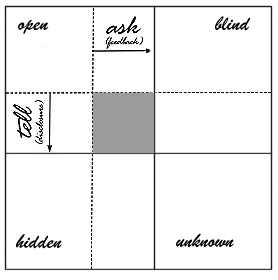 |
|||||
| |
|
|
|
|
|
Module One |
Reading One: Teaching and Self Understanding |
Two communications experts tried to describe this as a window. Here is their illustration, describing the difficulty in understanding ourselves and others.
JoHari window |
Communication Patterns explained |
|
 |
OPEN |
BLIND We do not realize these things about ourselves, and others do not either |
HIDDEN We knowand do not want others to know |
UNKNOWN Others know this about usandwe don't know it |
|
Developed by Joseph Luft and Harry Ingham |
||
| Open: The open area is that part of our conscious self - our attitudes, behavior, motivation, values, way of life - of which we are aware and which is known to others. We move within this area with freedom. We are "open books". | Blind: There are things about ourselves which we do not know, but that others can see more clearly; or things we imagine to be true of ourselves for a variety of reasons but that others do not see at all. When others say what they see (feedback), in a supportive, responsible way, and we are able to hear it; in that way we are able to test the reality of who we are and are able to grow. |
| Hidden: Our hidden area cannot be known to others unless we disclose it. There is that which we freely keep within ourselves, and that which we retain out of fear. The degree to which we share ourselves with others (disclosure) is the degree to which we can be known. | Unknown: We are more rich and complex than that which we and others know, but from time to time something happens - is felt, read, heard, dreamed - something from our unconscious is revealed. Then we "know" what we have never "known" before. |
Copied from http://www.freemaninstitute.com/johari.htm
Share with the class what you think about this idea of knowing and hiding from self using the WebCT Discussion board